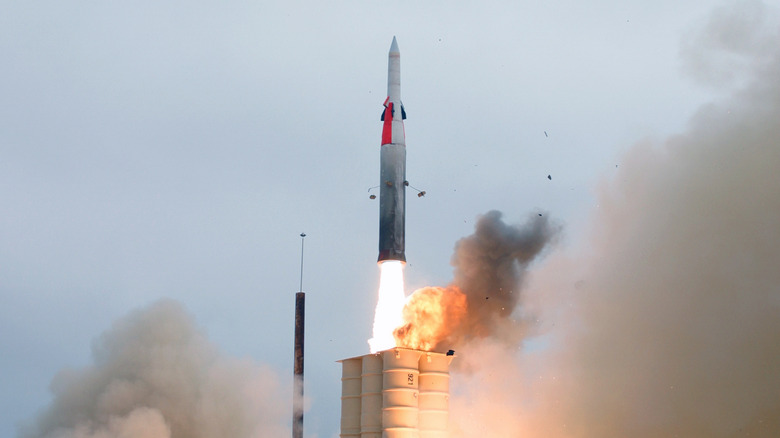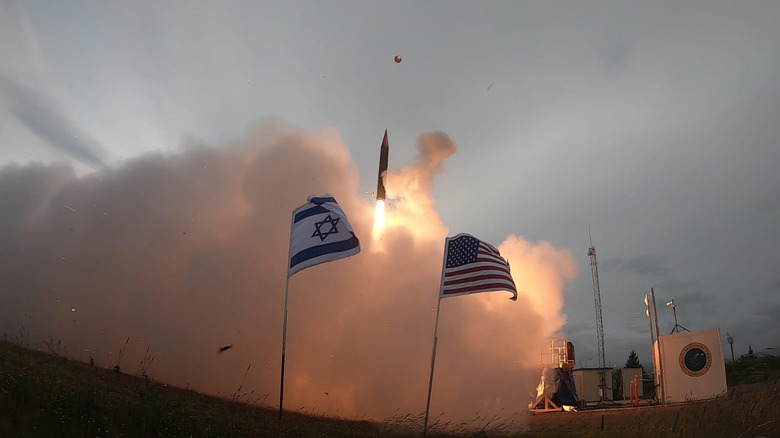How Israel's Air-Defense Systems Intercept Ballistic Missiles In Outer Space
Overnight on April 13, 2024, Iran launched a huge missile barrage aimed at Israel. In response, Israel and its allies executed a successful missile defense operation dubbed "Iron Shield." Israel's military confirmed the following day, that out of hundreds of ballistic missiles and drones sent by Iran, 99 percent were intercepted and shot down. This ad-hoc missile defense coalition utilized several technologies, ranging from the U.S. Aegis system to Israel's Iron Dome and even F-15 fighter-launched missile interceptions.
Furthermore, videos recorded by civilians on the ground have provided an unprecedented opportunity to look at one element of Israel's air defense apparatus in action: the Arrow 3, or Hetz 3.
The Arrow 3 system is remarkable because it uses hypersonic missiles to intercept incoming threats in space, directly colliding with them — known as hit-to-kill — before the offensive reenters the earth's atmosphere. During Iran's attack, the impact of these interceptions could be seen with explosions at high altitudes illuminating the night sky.
[Featured image by Bricktop via Wikimedia Commons | Cropped and scaled | Public Domain]
Anatomy of the Arrow 3
The Arrow 3 is the most advanced branch of Israel's comprehensive integrated air defense system. Designed to intercept high, fast-flying ballistic missiles, it uses a two-stage exo-atmospheric kill vehicle capable of neutralizing threats even when they're outside the earth's atmosphere. The first boosting stage consists of a solid rocket motor, equipped with a thrust-vectoring nozzle, to propel the kill vehicle to the edge of space and bring it close to the threat. Then, the interceptor separates from the booster. A gimbaled seeker and inertial navigation system kicks in to track where the threat is and directs the kill vehicle's sustainer thruster to head directly at it — eventually crashing into the target and destroying it.
What sets the Arrow 3 apart is its cost-effectiveness. Despite its capability to intercept intercontinental ballistic missiles at altitudes exceeding 62 miles, it comes at a fraction of the cost compared to other systems. The interceptor missiles each cost a reported $3-$3.5 million, a stark comparison to the Standard Missile-3 (SM-3) — possibly also used in the defensive action against Iran, by the U.S. military – which ranges from $9-$27 million per shot. Moreover, beyond its primary role in missile defense, Israel is exploring the Arrow 3's potential as an anti-satellite weapon, capitalizing on its capability to operate beyond the Earth's atmosphere.
[Image by Ronite via Wikimedia Commons | Cropped and scaled | CC BY-SA 4.0]
Why the Arrow 3 intercepts missiles in space
Unlike the widely recognized Iron Dome system, which defends against threats within close range (between 2.5 to 43 miles), the Arrow 3 operates during the midcourse phase of a missile's trajectory, intercepting it while it's still in space. This phase provides an optimal opportunity for interception since missiles travel at slower speeds compared to the final phase of a missile's flight — the terminal phase. Once a missile has entered the terminal stage, it accelerates to incredible speeds, that can be greater than 1,988 mph. While intercepting at this point is not impossible, as demonstrated by the Terminal High Altitude Air Defense system used by the U.S., it's very difficult.
However, neutralizing missiles during the midcourse phase also presents its own set of difficulties. The interceptor must cover a vast distance to reach space and match the speed of the threat before it enters the terminal phase. Consequently, the kill vehicle has an impressive range of 1,500 miles and is equipped with a powerful motor capable of propelling it to hypersonic speeds (Mach 5+).Using a thrust-vectoring nozzle, the kill vehicle can flexibly adjust its trajectory to intersect with the incoming missile. Then, multiple guidance systems, including a gimbaled seeker, will precisely align it with the missile's path.
[Featured image by the IDF via Wikimedia Commons | Cropped and scaled | Public Domain]


